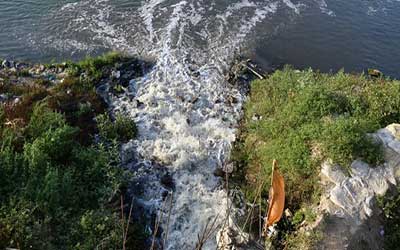Date: 24/5/2023
Relevance: GS-2: Conservation, environmental pollution and degradation, environmental impact assessment.
Key Phrases: Namami Gange Initiative, Wildlife Institute of India, Ganga Prahari, Gangetic Dolphin, Ganga River, Pollution, Environmental Degradation, National Mission for Clean Ganga.
Context:
- Over 4,000 volunteers under the Namami Gange initiative have been keeping a check on littering and poaching in the river to make sure that its flora, fauna are intact; in return, the Wildlife Institute of India has helped them with livelihood training.
Introduction
- The Ganga River, often considered sacred and revered in India, has been facing numerous challenges due to pollution and environmental degradation.
- To address this pressing issue, the National Mission for Clean Ganga and the Wildlife Institute of India (NMCG-WII) has established a task force called the Ganga Prahari.
- This group of dedicated volunteers aims to protect and restore
the Ganga River and its surrounding ecosystem, covering a vast area of 8.61
billion square kilometers.
- With over 4,000 volunteers in 100 districts across five states, the Ganga Prahari task force plays a crucial role in safeguarding the river and its diverse wildlife.
Key Takeaways:
- The Ganga Prahari project began in 2016 as part of the Namami Gange program, which focuses on cleaning the river, its ecosystem, and the villages situated along its banks.
- Through their training, volunteers like Omveer Kumar, who is
passionate about the Ganga River, have gained knowledge about the various
species inhabiting the river and its importance for the food cycle and human
survival.
- Mr. Kumar's dedication is exemplary, as he not only helps clean up the riverbanks but also rescues injured wildlife like the wounded turtle he found.
- This level of commitment is shared by his fellow volunteers, who work tirelessly to prevent littering, report poaching activities, and protect the river from further degradation.
Challenges Faced by the Ganga Prahari
- While the Ganga Prahari task force is making significant efforts
to combat pollution and protect the river, they face various challenges in
their mission.
- One such challenge is the resistance they encounter from certain individuals who refuse to comply with regulations.
- Some even resort to threatening the volunteers, demanding their
identification cards, and physically pushing them.
- To address this issue and enhance the effectiveness of the Ganga Prahari, plans are underway to issue official ID cards to all volunteers.
- These ID cards will serve as a means to validate their authority and provide a sense of legitimacy when dealing with uncooperative individuals.
Conservation Efforts and the Threat to Gangetic Dolphins
- The Ganga River is home to the Gangetic dolphin, India's national aquatic animal, which is currently endangered. At present, there are approximately 3,600 Gangetic dolphins in the river.
- In the past, dolphin poaching was driven by a belief among villagers that dolphin skin oil could heal wounds quickly. Such practices posed a significant threat to the survival of these majestic creatures.
- Through the concerted efforts of the Ganga Prahari task force and
other conservation initiatives, steps have been taken to raise awareness
about the importance of protecting Gangetic dolphins and their habitat.
- By educating local communities, the task force aims to eliminate harmful practices and ensure the survival of this iconic species.
Obstacles and Opportunities for Livelihood Improvement
- While the Ganga Prahari project primarily focuses on river
conservation, it also presents opportunities for improving the livelihoods
of the local communities.
- Recognizing the importance of incentivizing participation, the Wildlife Institute of India (WII) offers various skill development and training programs to the volunteers.
- These programs cater to different interests and professions, ranging from beautician courses to electrician training. By equipping the volunteers with new skills, they not only contribute to the conservation efforts but also enhance their own employability.
- This holistic approach strengthens the bond between the Ganga Prahari and the communities they serve, fostering a sense of ownership and sustainable engagement.
Success Stories and Future Plans
- The impact of the Ganga Prahari project can already be seen in the lives of the people involved. Poonam Devi, a young woman from Katia village in Muzaffarnagar district, Uttar Pradesh, now runs a successful beauty parlor in her village, providing a source of income for her family.
- Similarly, in Diamond Harbour, West Bengal, Sajal Kanti Kayal manages a production unit where female Ganga Prahari volunteers create various products such as cloth bags, junk jewelry, and cloth sanitary pads.
- These products are not only environmentally friendly but also generate income for the women involved. Additionally, plans are underway to showcase these products at Dilli Haat in Delhi, providing a broader market for the Ganga Prahari's initiatives.
Conclusion
- The Ganga Prahari task force is playing a vital role in
protecting and reviving the Ganga River.
- Through their efforts, they not only combat pollution and preserve biodiversity but also engage with local communities and improve livelihoods.
- The task force faces challenges along the way, but their determination and dedication are commendable.
- As they continue their journey as guardians of the Ganga, it is crucial for government agencies, NGOs, and individuals to support and recognize their invaluable contributions. Together, we can ensure a cleaner and healthier Ganga River for generations to come.
Source: The Hindu
Mains Question:
Q. Describe the role and impact of the Ganga Prahari task force in the conservation and rejuvenation of the Ganga River. Discuss the challenges faced by the task force and suggest measures to further enhance its effectiveness. (250 words)






















